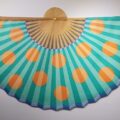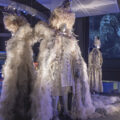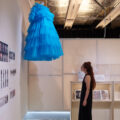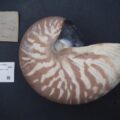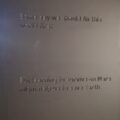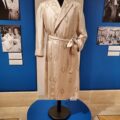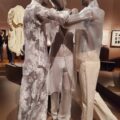Sargent and Fashion Review
April 15, 2024Sargent and Fashion Review. This very popular exhibition uses fashion to hang its premise on, but is mostly just a wonderful overview of Sargent’s career in portraits.
It was very unusual for any great portraitist not to be aware of the clothes of their sitter, and anyone who could portray silk, satin, velvet, and gold trims, or even highly decorative lace was prized. Because what is a portrait for? To record the face of your beloved wife on the moment of your wedding? No, it’s to show everyone the beyond expensive fine calf skin gloves you gave her on your betrothal. And the ancestral diamonds you decked her in on your marriage. Plus, the fine white lace collar she wears. Not only is lace very expensive, as it is woven painstakingly slowly by hand, but white things require a laundry maid to keep them sparkling clean and expertly ironed. So is it a portrait of your wife or your wealth? Both. But mostly the latter.
So it’s no surprise that Sargent, such a favourite, has given us ample material (ahem) for this exhibition on Sargent and Fashion. And we are exceedingly lucky that many of the original gowns seen in the portraits still exist for comparison.
Sargent and Fashion Review
Ironically, fashion wise, he is perhaps most famous for his “Portrait of Madame X”. This is painting of a woman in a gown so starkly and sinuously simple that it could be worn by any Oscar winner today, since the fashion has turned back to heavy corseting. The fame comes from the scandal. It is so simple that when originally painted, the slipping shoulder strap indicating an imminent undress was immediately obvious. This strap was painted out and re-painted many times. In an unfinished replica painted by the artist himself, the strap does not appear at all, suggesting a hesitancy about the whole business.
There is a photo of the pose, and Sargent plaintively claimed he painted the work just as the photo. He did, but he presumably set the strap there himself. He was well known for altering the way clothes sat on his subjects. The painter so far as to tuck and pin clothing to his liking, sometimes pricking the sitter in the process. “Madame X”’s mother complained it had damaged her daughter’s reputation. It damaged Sargent’s when it was shown at the French salon, with critics complaining that it was a publicity stunt. He actually kept the painting, feeling it was the best he’d ever done.
Strong Women, painted to Show Character

Mrs Edward Darley Boit (Mary Louisa Cushing) Photo by Genevieve Jones at Tate Britain.

Sargent and Fashion review. Jane Evans. Image by Genevieve Jones, taken at Tate Britain.

Mrs Edward L Davis (Maria Robbins) and her son, Livingston Davis. Image by Genevieve Jones, taken at Tate Britain
Portrait of Madame X shows her in profile, squinting off at something unseen. Strangely it’s her sweetly reddened ears that are at the centre here, echoed by the just seen red lipstick. But other sitters face Sargent head on, and their gaze is very direct. Mrs Edward L Davis (Maria Robbins), a portrait of a Boston society matron stares right at you, as does Jane Evans, a headmistress. In both cases the effect is strikingly modern. These women do not cast their glances down or to the side. They are also not shown as younger or more beautiful. He revels in their character – the strength and straightforwardness of the headmistress, the confidence of the society matron, and, shown nearby, the playfulness of Mrs Edward Darley Boit (Mary Louisa Cushing), seen nearby, who wears bright pink polka dotted skirts with a pink feather in her grey hair.
Sargent and Fashion Review – Carnation, Lily, Lily, Rose

Carnation, Lily, Lily, Rose. Photo by Genevieve Jones.
In the next room is the most beautiful “Carnation, Lily, Lily, Rose”. I knew of this painting since I was a very small child, because of the book The Family From One End Street, by Eve Garnett, written in 1937. It is about a very poor family from Sussex. In the story the parents, before marriage, go to London for the day.
“Amongst other places they visited the Tate Gallery where they saw a picture – ” “Lovely”, to Rosie’s way of thinking, and “That Real”, though at the same time confusing. It was called, “Carnation, Lily, Lily, Rose,” and it showed two children among the flowers at dusk engaged in hanging up Japanese lanterns. Rosie was undecided whether the title referred to the flowers or the children; each was spelt with a capital letter, but the actual flowers were rather vague whereas the children were solid enough; but then, why was Lily there twice over and could one call a child Carnation? ”. The painting makes enough of an impression on Rosie that she names her child Lily Rose. And clearly it made an impression on Eve Garnett too, as it must have struck many generations the same way.
This painting, with rosy flushed children in fluffy white dresses is in great contrast to the sophisticated Madame X. Deliberately so. Although it is a complicated and sophisticated melding of techniques and a show of technical ability in its capturing of twilight, and those white dresses were specially made and slipped on just before each posing session, its innocent essence mended his reputation and it was bought for the British nation through the Chantry Bequest.
Sargent and Fashion Review – An Artist in Control
The subjects are well aware of the power of their dress. They often wanted to be painted in one outfit, when Sargent stubbornly insisted on another. In some cases he’d rather wrap them in a length of silk in the colour he preferred, than the dress they proposed. Gretchen Warren wanted a favourite green dress, but her daughter, Rachel, got a length of pink satin and she herself, according to legend, had to borrow something from her sister, which didn’t actually fit.
Elanora Iselin showed him a selection of Parisian gowns but he painted her in her black afternoon dress that he first met her in. On other occasions he went the other way. The painter himself commissioned Worth to create a fancy dress costume for Sybil Sassoon, designed to resemble. Sassoon really liked dressing up, but with a Worth dress costing about £25,000 in today’s money, I wonder who paid?
There is much more to see here than I have space to talk about. The exhibition includes many military commissions, presidents and writers. There is a beautiful Worth dress, and the costume of Ellen Terry as Lady Macbeth. There are fewer clothes than might be expected, and they don’t always exactly match the subject. Perhaps they didn’t travel from the parent exhibition in Boston. But go instead for the paintings.
Apologies for the bad quality of the photos. The exhibition was crowded, and I snatched these where I could. If you can, it is recommended, as always, to go in person.






